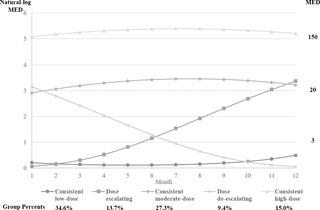Our official English website, www.x-mol.net, welcomes your
feedback! (Note: you will need to create a separate account there.)
Trends in prescription opioid use and dose trajectories before opioid use disorder or overdose in US adults from 2006 to 2016: A cross-sectional study.
PLOS Medicine ( IF 10.5 ) Pub Date : 2019-11-05 , DOI: 10.1371/journal.pmed.1002941 Yu-Jung Jenny Wei 1, 2 , Cheng Chen 1 , Roger Fillingim 3, 4 , Siegfried O Schmidt 5 , Almut G Winterstein 1, 2, 6
PLOS Medicine ( IF 10.5 ) Pub Date : 2019-11-05 , DOI: 10.1371/journal.pmed.1002941 Yu-Jung Jenny Wei 1, 2 , Cheng Chen 1 , Roger Fillingim 3, 4 , Siegfried O Schmidt 5 , Almut G Winterstein 1, 2, 6
Affiliation

|
BACKGROUND
With governments' increasing efforts to curb opioid prescription use and limit dose below the Centers for Disease Control and Prevention (CDC)-recommended threshold of 90 morphine milligram equivalents per day, little is known about prescription opioid patterns preceding opioid use disorder (OUD) or overdose. This study aimed to determine prescribed opioid fills and dose trajectories in the year before an incident OUD or overdose diagnosis using a 2005-2016 commercial healthcare database.
METHODS AND FINDINGS
This cross-sectional study identified individuals aged 18 to 64 years with incident OUD or overdose in the United States. We measured the prevalence of opioid prescription fills and trajectories of opioid morphine equivalent dose (MED) prescribed during the 12-month period before the diagnosis. Of 227,038 adults with incident OUD or overdose, 33.1% were aged 18 to 30 years, 52.9% were males, and 85.0% were metropolitan residents. Half (50.5%) of the patients had a diagnosis of chronic pain, 32.7% had depression, and 20.3% had anxiety. Overall, 79,747 (35.1%) patients filled no opioid prescription in the 12 months before OUD or overdose diagnosis, with the proportion significantly increasing between 2006 and 2016 (adjusted prevalence ratio, 1.86; 95% CI 1.79-1.93; P < 0.001). Patients without (versus with) prescribed opioids tended to be younger males and metropolitan and Northeast US residents. Of 145,609 patients who filled opioid prescriptions, 5 distinct prescribed daily dose trajectories preceding diagnosis emerged: consistent low dose (<3 mg MED, 34.6%), consistent moderate dose (20 mg MED, 27.3%), consistent high dose (150 mg MED, 15.0%), escalating dose (from <3 to 20 mg MED, 13.7%), and de-escalating dose (from 20 to <3mg MED, 9.4%). Overall, over two-thirds of patients with OUD or overdose with prescription opioids were prescribed a mean daily dose below 90 mg MED before diagnosis. Major limitations include the limited generalizability of the study findings and lack of information on out-of-pocket drug spending, race/ethnicity, and socioeconomic status of participants, which prevents analyses addressing these characteristics.
CONCLUSIONS
In this study, we found that absence of opioid prescription fills in the year before incident OUD or overdose diagnosis was prevalent, and the majority of the patients received prescription opioid doses below the risk threshold of 90 mg MED. An increasing proportion of high-risk patients could be missed by current programs solely based on opioid prescribing and dispensing information in this new era of limited access to prescription opioids.
中文翻译:

2006 年至 2016 年美国成年人阿片类药物使用障碍或过量之前的处方阿片类药物使用趋势和剂量轨迹:一项横断面研究。
背景随着各国政府加大力度遏制阿片类处方药的使用,并将剂量限制在疾病控制与预防中心 (CDC) 建议的每天 90 吗啡毫克当量的阈值之下,人们对阿片类药物使用障碍 (OUD) 之前的处方阿片类药物模式知之甚少。或服用过量。本研究旨在使用 2005-2016 年商业医疗保健数据库确定 OUD 或过量诊断事件前一年的处方阿片类药物填充和剂量轨迹。方法和结果 这项横断面研究确定了美国 18 至 64 岁之间发生 OUD 或用药过量的个体。我们测量了诊断前 12 个月内阿片类药物处方配药率和阿片类药物吗啡当量剂量 (MED) 的轨迹。在 227,038 名发生 OUD 事件或服药过量的成年人中,33.1% 年龄在 18 至 30 岁之间,52.9% 是男性,85.0% 是大都市居民。一半(50.5%)的患者被诊断为慢性疼痛,32.7%患有抑郁症,20.3%患有焦虑症。总体而言,79,747 名患者 (35.1%) 在 OUD 或用药过量诊断前 12 个月内没有服用阿片类药物处方,这一比例在 2006 年至 2016 年间显着增加(调整后患病率,1.86;95% CI 1.79-1.93;P < 0.001) 。未使用(与使用)处方阿片类药物的患者往往是年轻男性以及美国大都市和东北部居民。在 145,609 名服用阿片类药物处方的患者中,诊断前出现了 5 种不同的每日处方剂量轨迹:一致的低剂量(<3 mg MED,34.6%)、一致的中剂量(20 mg MED,27.3%)、一致的高剂量(150 mg MED) ,15.0%)、递增剂量(从 <3 至 20 mg MED,13.7%)和递减剂量(从 20 至 <3mg MED,9.4%)。 总体而言,超过三分之二的 OUD 或处方阿片类药物过量患者在诊断前平均每日剂量低于 90 mg MED。主要局限性包括研究结果的普遍性有限,以及缺乏有关自付费用药物支出、种族/族裔和参与者社会经济地位的信息,这阻碍了针对这些特征的分析。结论 在这项研究中,我们发现在 OUD 事件或过量诊断发生前一年,缺乏阿片类药物处方的情况很普遍,并且大多数患者接受的处方阿片类药物剂量低于 90 mg MED 的风险阈值。在处方阿片类药物获取有限的新时代,仅基于阿片类药物处方和配药信息的当前计划可能会错过越来越多的高风险患者。
更新日期:2019-12-03
中文翻译:

2006 年至 2016 年美国成年人阿片类药物使用障碍或过量之前的处方阿片类药物使用趋势和剂量轨迹:一项横断面研究。
背景随着各国政府加大力度遏制阿片类处方药的使用,并将剂量限制在疾病控制与预防中心 (CDC) 建议的每天 90 吗啡毫克当量的阈值之下,人们对阿片类药物使用障碍 (OUD) 之前的处方阿片类药物模式知之甚少。或服用过量。本研究旨在使用 2005-2016 年商业医疗保健数据库确定 OUD 或过量诊断事件前一年的处方阿片类药物填充和剂量轨迹。方法和结果 这项横断面研究确定了美国 18 至 64 岁之间发生 OUD 或用药过量的个体。我们测量了诊断前 12 个月内阿片类药物处方配药率和阿片类药物吗啡当量剂量 (MED) 的轨迹。在 227,038 名发生 OUD 事件或服药过量的成年人中,33.1% 年龄在 18 至 30 岁之间,52.9% 是男性,85.0% 是大都市居民。一半(50.5%)的患者被诊断为慢性疼痛,32.7%患有抑郁症,20.3%患有焦虑症。总体而言,79,747 名患者 (35.1%) 在 OUD 或用药过量诊断前 12 个月内没有服用阿片类药物处方,这一比例在 2006 年至 2016 年间显着增加(调整后患病率,1.86;95% CI 1.79-1.93;P < 0.001) 。未使用(与使用)处方阿片类药物的患者往往是年轻男性以及美国大都市和东北部居民。在 145,609 名服用阿片类药物处方的患者中,诊断前出现了 5 种不同的每日处方剂量轨迹:一致的低剂量(<3 mg MED,34.6%)、一致的中剂量(20 mg MED,27.3%)、一致的高剂量(150 mg MED) ,15.0%)、递增剂量(从 <3 至 20 mg MED,13.7%)和递减剂量(从 20 至 <3mg MED,9.4%)。 总体而言,超过三分之二的 OUD 或处方阿片类药物过量患者在诊断前平均每日剂量低于 90 mg MED。主要局限性包括研究结果的普遍性有限,以及缺乏有关自付费用药物支出、种族/族裔和参与者社会经济地位的信息,这阻碍了针对这些特征的分析。结论 在这项研究中,我们发现在 OUD 事件或过量诊断发生前一年,缺乏阿片类药物处方的情况很普遍,并且大多数患者接受的处方阿片类药物剂量低于 90 mg MED 的风险阈值。在处方阿片类药物获取有限的新时代,仅基于阿片类药物处方和配药信息的当前计划可能会错过越来越多的高风险患者。











































 京公网安备 11010802027423号
京公网安备 11010802027423号